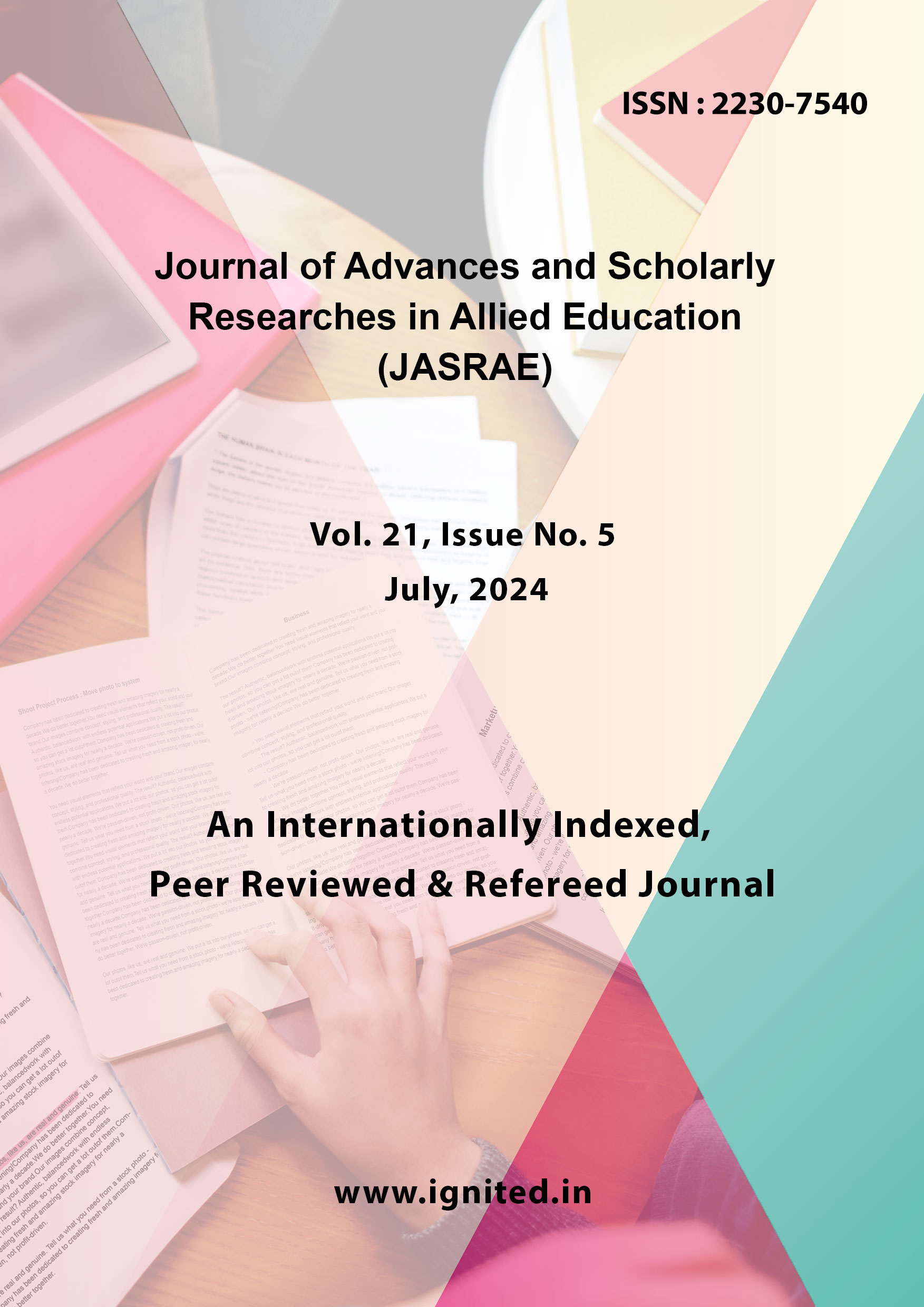A Study of Academic Achievement among Adolescents Belonging to Different Sociometric Groups
DOI:
https://doi.org/10.29070/r98cas55Keywords:
Acceptability, Academic Achievement, Sociometric Status, Rejection, AdjustmentAbstract
Being accepted in the class makes the students feel like they belong to the group that moulds positive qualities in him/or her. Formation of such characteristics is helpful in encouraging desirable academic attainment. A certain positive relationship more or less with the academic achievement has the Sociometric status of pupils. Besides, the academic performance of students lies massive influence in their social acceptance by the group of people in the classroom which consequently creates positive or negative emotions about the prevailing situations or state of schools. The organization participants may be rejected sufficient to cause them to accumulate undesirable character traits that are intently related to their modifications inside the college. To a certain extent, this maladjustment immediately pertains to the academic performance of college students. within the research out of which the existing take a look at has emerged, the companies of adolescent students included were the Sociometric classes of the students studying in class X, popular, left out and rejected and remoted respectively which has been tabulated, and compared in phrases of instructional success inside the normal experience and inside the boys institution and in the ladies organization respectively. The excessive quotes of sex differences had been additionally analyzed amongst the companies of students that had been popular, neglected and rejected. This research was carried on 120 students which was categorized in terms of popular negligible and reject groups of students who were detected through administration of Sociometric Questionnaire. In respect to academic performance, the researcher approached the exam In charge of the selected schools and had to ask them about the marks that had been obtained by the students during last two annual examinations (IX and VIII classes). The facts changed into later analysed using the statistical strategies viz., imply, S.D., and C.R. approach.
References
Badami, H.D and Tripathi, B (1973) Group acceptance – rejection as a function of intelligence and scholasticachievement. Indian Journal of Psy., 48(1) 69 – 74.
Bhargava, Vidya (1964) “ A study of relationship of academic achievement to classroom friendship Pattern (asdetermined by Sociometric tests) and Persnality traits”. M.ed, unpublished dissertation, Central Institute of Edu; Delhi University,Delhi.
Bonney, M.E. and J. Powell (1953). “Differences in social behaviour between sociometrically high and Sociometricalllylow children”. Jl. Educl. Research 46: 481-495.
Brown, D. , (1954) Factors affecting Social acceptance of high School Students.” School Review 42 : 151-155.
Cattell, R.B. (1934). “Friendship and Enemies”. A Psychological study of character and temperament. Page 54-63.
Chapin, F.S. (1940). Trends in sociometrics and critique”. Sociometry, 3 : 245-262..
Feinberg, M.R. (1953). “Relation of Back ground Experience to Social Acceptance”. Jl. of Abnormal and Social Psy., 48 :206-214.
Singh Ram (2018). “Acadamic achievement of adolescent belonging to different sciometric groups: A comparative Analysis”. IJHSSI online page 23-31
Forlane, G. and J.W. Wrightstone (1951). “Sociometric self-Descriptive techniques in Approval of pupil Adjustment”.Sociometry, 14 : 340-350.
Gautam, P.N. (1974). “A Sociometric study of Patterns of social interactions among Principals, teachers and studentsin Higher Secondary Schools of H.P. Panjab University, Chandigarh.
Good, C.V, A.S. Barv and D.E. Scates (1941). “The Methodology of educational Research”. New York, Appleton CenturyCrofts Inc.
Gronlund, N.E. and Holmlund, W.S. (1958) – The value of Elementary School Sociometric scores for Predicting pupilsadjustment in High School Edul. Adm. and Supervision, 44, 255-60.
Grossman, B. and J. wrighter (1948). “The relationships between selection-Rejection and intelligence, Social status andPersonality Amongst sixth grade children”. Sociometry, 11 : 346-355
Gulati, J.P. (1956). “Fundamental Statistics in Psychology and Education”. New York Mc Graw Bill Book. Co.
Kumari, Sudha (1982). “A study of Intelligence, Achievement, Adjustment, Socio-economic Pattern of DifferentSociometric groups of Adolescents. A Ph. D thesis (unpublished)
Ram,Nek (2012): “Personality profile, reaction to frustration and problems of +2 students of different sociometriccategories”. An unpublished Ph.D thesis, University of Jammu, Jammu.
Rashmi (2013): “Academic achievement of 8th class students belonging to different sociometric groups”. Anunpublished dissertation at M.Ed .level at IGNOU RC Jammu.
Pathak, R. D. (1974). “Level of Sociometrically selected groups of Peers. Psychological studies, 19(2).Sociometric groupsof school children. Indian Journal of social work, 33, (3), 199-203.
Sharma, A.N. (1965). “Social Status of pupils and some factors related to it. Report No. 8. Department of PsychologicalFoundations N.C.E.R.T., New Delhi.
Sharma, Atmananda. (1970). “Handbook on Sociometry for teacher and counsellors”. Department of educational Psychologyand Foundations of Education National Institute of education, NCERT, New Delhi.
Sharma, H. and Malik. S. (1984). “A Sociometric Study of Personality patterns of Adolescent girls as measured through Freeexpression drawings. Trends in Education, 9(3), 4-16.
Sharma, Satya Parkash. (1968). “A Comparative Study of Personality traits of Populars and Rejectees. M.Eddissertation (Unpublished). Rajasthan University.
Sharma, V.M. (1965). “Some Determinants of Sociometric status. Jl. of education and Psychology, 23, 49-56.
Shukla, J.K. (1951). “A Study of Friendship”. Unpublished M.Ed Dissertation, Rajasthan University, Rajasthan.
Shukla, S.K. (1980). “Sociometric approach to Personality”. Jl. of Educational Research and extension. 17(1), 4-9.
Singh, Rekha. (1975). “A study of effect of Intelligence, socio-economic status and Academic Achievement as socialAcceptance. Unpublished M.Ed. Dissertation, Aligarh Muslim, University.
Singh, Udey Partap. (1963). “An Investigation into the characteristics of socially accepted and socially rejected boysof age group 14”. Unpublished M.Ed Dissertation, B.R. College of Education, Agra University.
Singhal, N. (1960). “Social Acceptance and Rejection as affected by Socio-economic status of girls Students of tenthGrade”. Unpublished M.Ed Dssertation,Central Insititute of Education, University of Delhi.
Smith, M. (1944). “Some factors in Friendship Slection of High school students”. sociometry, 7 : 303-310.
Stanley (1967), Tennings (1950), Bonner (1953), Herbert (1954). Studies quoted from the Ph. D. thesis of Sudha Kumari(1982) entitled “A study of Intelligence, Achievement, Adjustment, Socio-economic pattern of different sociometric groups ofadolescents”, (Unpublished), Panjab Universities, Chandigarh.
Vasu deva, P. and Verma, P. (1974). “Sociometric Status as related to achievement anxiety and intelligence. Jl. OfPsychological Researches 18, 93-95.
Verma L. K., and Sharma N. R. (1990). Statistics in Education and Psychology. Narinder Publishing House, Jalandhar











